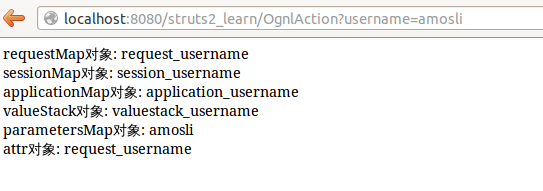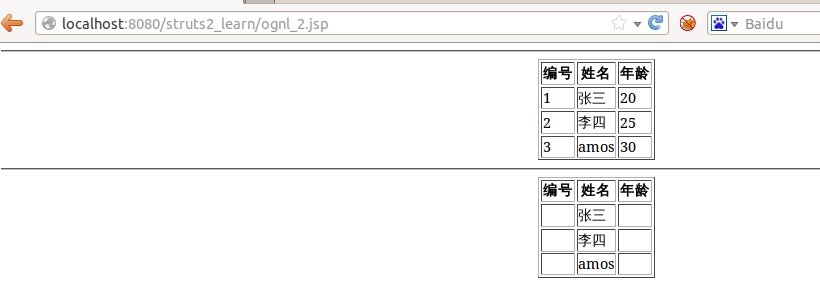java struts2入门学习--OGNL语言基本用法
一.知识点学习
1.struts2中包含以下6种对象,requestMap,sessionMap,applicationMap,paramtersMap,attr,valueStack;

1)requestMap用来存放包含当前HttpServletRequest的属性(attribute)的Map,简单来说就是request域中的值;
2)sessionMap用来存放包含当前HttpSession的属性(attribute)的Map
3)applicationMap用来存放包含当前应用的ServletContext的属性(attribute)的Map
4)paramtersMap包含当前HTTP请求参数的Map
5)attr,只是用来取值,用于按request > session > application顺序访问其属性(attribute)
6)valueStack值栈是Action的数据中心,关于Action中的所有Value都是存放在valueStack中.
2.OGNL几种常见的符号用法
<s:property value="#attr.username"/>会在以下几个域对象中依次查询
[pageContext对象]===>requestMap对象===>valueStack对象===>sessionMap对象===>applicationMap对象===>空白字符串
注意:pageContext对象不是Struts2的数据中心之一.
3.#用法:
1) <s:property value="#request.username"/> 作用于struts2的域对象,而不是普通域对象
2)<s:property value="#user.username"/>作用于JavaBean对象
3)<s:property value="#username"/><===><s:property value="username"/>作用于普通字符串
二.实例
1.源码
OgnlAction.java
package ognl;
import org.apache.struts2.ServletActionContext;
import com.opensymphony.xwork2.ActionContext;
import com.opensymphony.xwork2.ActionSupport;
public class OgnlAction extends ActionSupport {
private static final long serialVersionUID = -842453764814706964L;
public String execute() throws Exception {
// 放置在requestMap对象中 1
ServletActionContext.getRequest().setAttribute("username", "request_username");
// 放置在SessionMap对象中3
ActionContext.getContext().getSession().put("username", "session_username");
// 放置在ApplicationMap对象中
ServletActionContext.getServletContext().setAttribute("username", "application_username");
//放置在ValueStack对象中2
ActionContext.getContext().getValueStack().set("username", "valuestack_username");; return SUCCESS;
}
}
User.java
package ognl; /**
* @ClassName: User
* @Description: 用户
* @author: amosli
* @email:amosli@infomorrow.com
* @date Feb 17, 2014 11:00:11 PM
*/
//JavaBean对象
public class User {
private Integer id;// 编号
private String name;// 姓名
private Integer age;// 年龄
public User() {
}
public User(Integer id, String name, Integer age) {
super();
this.id = id;
this.name = name;
this.age = age;
}
public Integer getId() {
return id;
}
public void setId(Integer id) {
this.id = id;
}
public String getName() {
return name;
}
public void setName(String name) {
this.name = name;
}
public Integer getAge() {
return age;
}
public void setAge(Integer age) {
this.age = age;
}
}
struts.xml
<?xml version="1.0" encoding="UTF-8" ?>
<!DOCTYPE struts PUBLIC
"-//Apache Software Foundation//DTD Struts Configuration 2.3//EN"
"http://struts.apache.org/dtds/struts-2.3.dtd"> <struts>
<!--<include file="config/upload.xml"></include> -->
<!-- 加载其他配置文件 -->
<!-- <include file="config/upload-interceptor.xml"></include> -->
<!-- 加载属性文件-国际化 -->
<!-- <constant name="struts.custom.i18n.resources" value="message"></constant> --> <!-- 结果集 -->
<!-- <include file="config/result_struts.xml"></include> -->
<!-- 类型转换 -->
<!-- <include file="config/type_struts.xml"></include> -->
<!-- 文件下载 -->
<!-- <include file="config/download_struts.xml"></include> -->
<!-- 验证validator -->
<!-- <include file="config/validator_struts.xml"></include> --> <!-- ognl语言表达式 -->
<include file="config/ognl_struts.xml"></include>
</struts>
ognl_struts.xml
<?xml version="1.0" encoding="UTF-8" ?>
<!DOCTYPE struts PUBLIC
"-//Apache Software Foundation//DTD Struts Configuration 2.3//EN"
"http://struts.apache.org/dtds/struts-2.3.dtd"> <struts>
<package name="ognl" extends="struts-default">
<action name="OgnlAction" class="ognl.OgnlAction" method="execute">
<result name="success" type="dispatcher">
/WEB-INF/ognl_success.jsp
</result>
</action>
</package>
</struts>
ognl_2.jsp
<%@ page language="java" contentType="text/html; charset=UTF-8"
pageEncoding="UTF-8"%>
<%@ taglib uri="/struts-tags" prefix="s" %>
<%@ page import="java.util.*" %>
<%@ page import="ognl.User" %>
<!DOCTYPE html PUBLIC "-//W3C//DTD HTML 4.01 Transitional//EN" "http://www.w3.org/TR/html4/loose.dtd">
<html>
<head>
<meta http-equiv="Content-Type" content="text/html; charset=UTF-8">
<title>Insert title here</title>
</head>
<body>
<%
List<User> userList = new ArrayList<User>();
userList.add(new User(1,"张三",20));
userList.add(new User(2,"李四",25));
userList.add(new User(3,"amos",30));
pageContext.setAttribute("userList", userList);
%>
<hr>
<table border="1" align="center">
<tr>
<th>编号</th>
<th>姓名</th>
<th>年龄</th>
</tr>
<s:iterator var="user" value="#attr.userList">
<tr>
<td><s:property value="#user.id"/></td>
<td><s:property value="#user.name"/></td>
<td><s:property value="#user.age"/></td>
</tr>
</s:iterator>
</table>
<!-- 只取name一列 -->
<hr>
<table border="1" align="center">
<tr>
<th>编号</th>
<th>姓名</th>
<th>年龄</th>
</tr>
<s:iterator var="username" value="#attr.userList.{name}">
<tr>
<td></td>
<!-- #在这里加不加都是一样的 -->
<td><s:property value="#username"/></td>
<td></td>
</tr>
</s:iterator>
</table>
</body>
</html>
ognl_success.jsp
<%@ page language="java" contentType="text/html; charset=UTF-8"
pageEncoding="UTF-8"%>
<%@ taglib uri="/struts-tags" prefix="s" %>
<!DOCTYPE html PUBLIC "-//W3C//DTD HTML 4.01 Transitional//EN" "http://www.w3.org/TR/html4/loose.dtd">
<html>
<head>
<meta http-equiv="Content-Type" content="text/html; charset=UTF-8">
<title>Insert title here</title>
</head>
<body>
requestMap对象: <s:property value="#request.username"/><br>
sessionMap对象: <s:property value="#session.username"/><br>
applicationMap对象: <s:property value="#application.username"/><br>
valueStack对象: <s:property value="username"/><br>
parametersMap对象: <s:property value="#parameters.username"/><br>
attr对象: <s:property value="#attr.username"/>
</body>
</html>
2.效果图
1).验证上面所说的6个对象

2)#的用法

3.源码分析
1)struts.xml在程序运行时就被加载到内存中,struts.xml加载了config/ognl_struts.xml.
2)config/ognl_struts.xml中配置了ognl.OgnlAction,如果成功那么页面转发到/WEB-INF/ognl_success.jsp
3)OgnlAction.java中为除了attr外的5种对象赋值.
4)WEB-INF/ognl_success.jsp中取出OgnlAction中的赋值.
其中取值的方式<s:property value="#request.username"/>,主要用到#的第一种用法.
<s:property value="#attr.username"/>,主要可以用来测试attr取值的顺序.
5)User.java定义了一个JavaBean对象,包含三个字段id,name,age;
6)ognl_2.jsp,新建list,将定义的JavaBean对象的值赋给userList,并将值传递到当前页面pageContext中.
<s:iterator var="user" value="#attr.userList">
<tr>
<td><s:property value="#user.id"/></td>
<td><s:property value="#user.name"/></td>
<td><s:property value="#user.age"/></td>
</tr>
</s:iterator>
其中使用#attr来获取pageContext中的内容.然后使用<s:iterator>标签进行遍历,并将值存放到user中.
然后再通过#user.id来取出变量user中id的值,这里也表现了JavaBean对象中非值栈中的value,一定要记得加上#
取单个值的格式如下,#attr.userList.{name}只取userList中的name这一列.
<s:iterator var="username" value="#attr.userList.{name}">
<tr>
<td></td>
<!-- #在这里加不加都是一样的 -->
<td><s:property value="#username"/></td>
<td></td>
</tr>
</s:iterator>
针对不JavaBean对象,加不加#效果是一样的.
4.本文源码链接
java struts2入门学习--OGNL语言基本用法的更多相关文章
- java struts2入门学习--OGNL语言常用符号和常用标签学习
一.OGNL常用符号(接上一篇文章): 1.#号 1)<s:property value="#request.username"/> 作用于struts2的域对象,而不 ...
- java struts2入门学习--防止表单重复提交.OGNL语言学习
一.知识点回顾 防止表单重复提交核心思想: 客户端和服务器端和写一个token,比较两个token的值相同,则非重复提交;不同,则是重复提交. 1.getSession三种方式比较: request. ...
- java struts2入门学习实例--将客户端IP地址和访问方式输出到浏览器
实例1:实现客户端IP地址和访问方式输出到浏览器. IpAction.java package com.amos.web.action; import javax.servlet.http.HttpS ...
- java struts2入门学习--基于xml文件的声明式验证
一.知识点总结 后台验证有两种实现方式: 1 手工验证顺序:validateXxx(针对Action中某个业务方法验证)--> validate(针对Action中所有的业务方法验证) 2 声明 ...
- java struts2入门学习---国际化
一.国际化的概念 1.不同国家的人访问同一个网站,显示的语言不同. 2.对JSP页面进行国际化 属性(properties)文件命名规则:基名---语言--国家如, message_zh_CN.pro ...
- java struts2入门学习---拦截器学习
一.拦截器,拦截器栈 1.拦截器的作用 拦截器本质上和servlet的过滤器是一样的.在struts2中,拦截器能够对Action前后进行拦截,拦截器是一个可插拨的,你可以选择使用拦截器,也可以卸载拦 ...
- java struts2入门学习实例--使用struts2快速实现上传
一.文件上传快速入门 1).关于上传表单三要素 >>尽量以POST请求方式上传,因为GET支持文件大小是有限制的. >>必须要加上enctype="multipart ...
- java struts2入门学习---自定义类型转换
自定义类型转换器的作用就是将struts无法识别的类型转换成自己所需要的. 比如输入:广东-东莞-虎门,对应的输出时能输出:广东省 东莞市 虎门(镇/区) 这里涉及到的知识点即是将String转换为任 ...
- java struts2入门学习---文件下载的二种方式
一.关于文件下载: 文件下载的核心思想即是将文件从一个地方拷贝到另一个地方. 1.传统方式: 在Action中加入大量servlet api 操作.优点是好理解,缺点是耦合度高. 2.stream方式 ...
随机推荐
- listview加载数据
首先我们需要理清思路:使用ListView显示数据是很方便的,ListVIew的数据之间通过适配器adapter去作为桥梁连接起来.当我们需要使用listview显示大量数据的时候,我们需要使用到分页 ...
- ML、DL相关资源
1. http://x-algo.cn/index.php/category/nlp/
- wifidog接口文档(转)
目录(?)[-] 网关心跳协议 请求信息 回复格式 例子 用户状态心跳协议 请求格式 注意 回复格式 状态码 例子 跳转协议 请求格式 例子 注册协议 请求格式 例子 wifidog是搭建无线热点认证 ...
- Sqlite向MySql导入数据
想把手上的Sqlite数据库导入到MySql,想来应该很简单,结果发现非常麻烦. 1.工具直接导入.试着找了几个软件,都不行.网上有人开发的,但是要收费,也不能用. 2.用各自支持的方式,中转.我用的 ...
- form表单自动回车提交
对于使用了submit按钮的form表单,浏览器会直接建立回车与submit按钮之间的关联
- Python标准库:内置函数type(object)
type(object) type(name, bases, dict) 本函数是返回对象的类型对象.仅仅有一个參数object时,直接返回对象的类型对象.假设仅仅是想推断一个对象是否属于某一个类的对 ...
- [信息检索] 第一讲 布尔检索Boolean Retrieval
第一讲 布尔检索Boolean Retrieval 主要内容: 信息检索概述 倒排记录表 布尔查询处理 一.信息检索概述 什么是信息检索? Information Retrieval (IR) is ...
- ArcMap工具箱参数名称的Bug
已经忍了很久了,今天一定要说一说,强大的 ArcGIS居然还存在这种Bug问题.如下图所示:使用了追加工具,有三个要素图层,且三个数据与目标数据不是同一数据,但它们的名称一致,这样执行,将会出现&qu ...
- Cocos开发小游戏如何实现微信排行榜
当游戏开发进入尾声,要引入微信数据的时候,需要了解和微信相关的接口了. 关系数据链 开放数据域 相关接口如下: wx.getFriendCloudStorage() 获取当前用户也玩该小游戏的好友的用 ...
- mysql的逻辑结构
mysql 数据库的逻辑架构如下图: 第一层,即最上一层,所包含的服务并不是MySQL所独有的技术.它们都是服务于C/S程序或者是这些程序所需要的 :连接处理,身份验证,安全性等等. 第二层值得关注. ...
